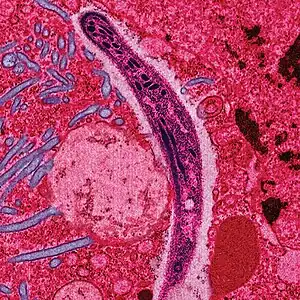Laverania
| Laverania | |
|---|---|
 | |
| This shows a sporozoite of Plasmodium bergei migrating through the cytoplasm of midgut epithelia of an Anopheles stephensi mosquito. | |
| Scientific classification | |
| Domain: | Eukaryota |
| (unranked): | Diaphoretickes |
| Clade: | SAR |
| Infrakingdom: | Alveolata |
| Phylum: | Apicomplexa |
| Class: | Aconoidasida |
| Order: | Haemospororida |
| Family: | Plasmodiidae |
| Genus: | Plasmodium |
| Subgenus: | Laverania Bray, 1958 |
| Species | |
|
See text | |
Laverania is a subgenus of the parasite genus Plasmodium. Infection with these species results in malaria. The subgenus was first described in 1958.[1]
The name was first proposed by Welch in 1897 as a genus name for the group now known as Plasmodium but for a variety of reasons the genus name Plasmodium was preferred.
Taxonomy
The first non human primate parasites were described by Eduard Reichenow in Cameroon in 1920. He observed three morphologically distinct Plasmodium parasites in the blood of chimpanzees and gorillas in 1917.[2] These finding were later confirmed by other workers.[3][4] One species closely resembled P. falciparum and was thought to be the same species. This species was later renamed P. reichenowi.[5]
The other two species — P. rhodaini and P. schwetzi — have since been placed in the subgenus Plasmodium.
The noticeable differences between P. falciparum and the other known Plasmodium species led to the proposal that it be placed in a separate genus Laverania.[1] This suggestion was not accepted but the proposed name is now used as the subgenus.
Species
It has been proposed to rename P. gora and P. gorb as Plasmodium adleri and Plasmodium blacklocki respectively.[6] It has also been proposed that P. billbrayi be considered a junior synonym of P. gaboni.[6]
- Plasmodium billcollinsi
- Plasmodium billbrayi
- Plasmodium falciparum
- Plasmodium gaboni
- Plasmodium gora
- Plasmodium gorb
- Plasmodium reichenowi
The full genomes of the seven species are now sequenced[7] and available on PlasmoDB.
References
- 1 2 Bray R.S. (1958). "Studies on malaria in chimpanzees. VI. Laverania falciparum". Am. J. Trop. Med. Hyg. 7 (1): 20–24. doi:10.4269/ajtmh.1958.7.20. PMID 13508992.
- ↑ Reichenow E. (1920). "Über das Vorkommen der Malariaparasiten des Menschen bei den Afrikanischen Menschenaffen". Centralbl. F. Bakt. I. Abt. Orig. 85: 207–221.
- ↑ Blacklock B.; Adler S. (1922). "A parasite resembling Plasmodium falciparum in a chimpanzee". Ann. Trop. Med. Parasitol. XVI: 99–107. doi:10.1080/00034983.1922.11684303.
- ↑ Adler, S. (1923). "Malaria in chimpanzees in Sierra Leone". Ann. Trop. Med. Parasitol. 17: 13–19. doi:10.1080/00034983.1923.11684345.
- ↑ Coatney, G.R.; National Institute of Allergy and Infectious Diseases (1971). The primate malarias. U.S. National Institute of Allergy and Infectious Diseases.
- 1 2 Rayner JC, Liu W, Peeters M, Sharp PM, Hahn BH (May 2011). "A plethora of Plasmodium species in wild apes: a source of human infection?". Trends Parasitol. 27 (5): 222–9. doi:10.1016/j.pt.2011.01.006. PMC 3087880. PMID 21354860.
- ↑ Otto TD, Gilabert A, Crellen T, Böhme U, Arnathau C, Sanders M, Oyola SO, Okouga AP, Boundenga L, Willaume E, Ngoubangoye B, Moukodoum ND, Paupy C, Durand P, Rougeron V, Ollomo B, Renaud F, Newbold C, Berriman M, Prugnolle F (June 2018). "Genomes of all known members of a Plasmodium subgenus reveal paths to virulent human malaria". Nature Microbiology. 3 (6): 687–97. doi:10.1038/s41564-018-0162-2. PMC 5985962. PMID 29784978.
"Plasmodium (Laverania)". NCBI Taxonomy Browser. 418107.